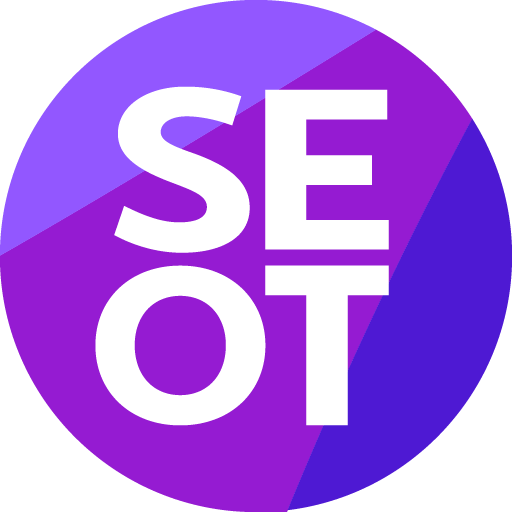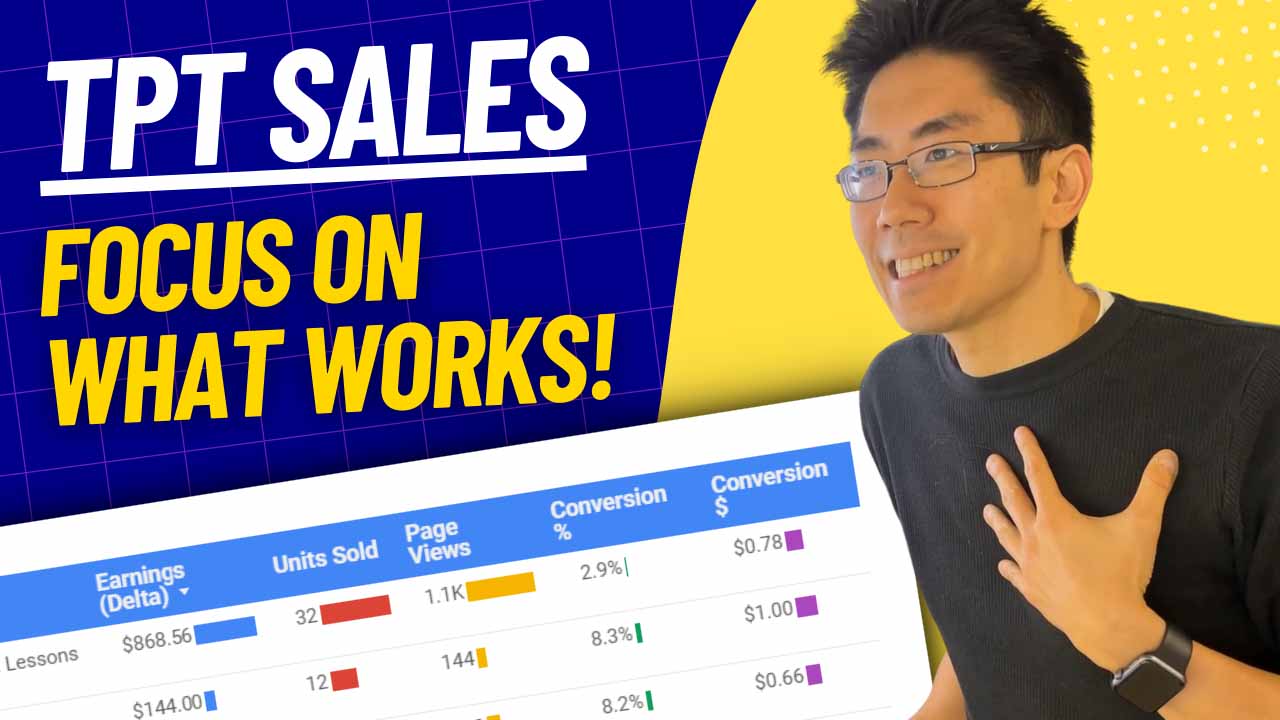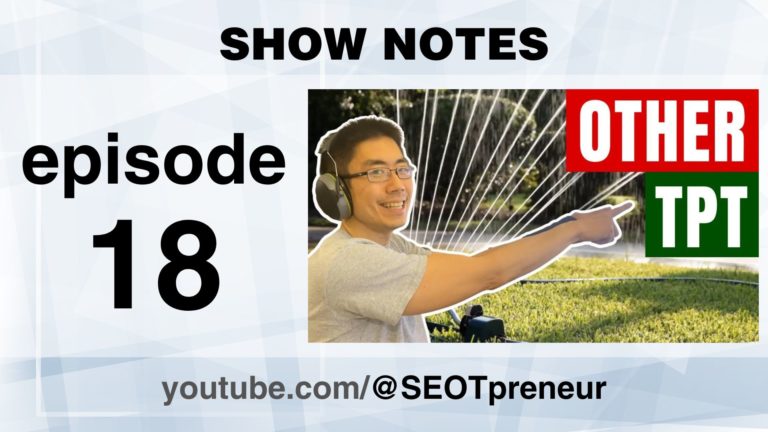Teachers Pay Teachers: Get More Sales – Focus on What Works! (Your FREE data playbook) – Episode 003
If you sell on Teachers Pay Teachers, get more sales by focusing on what works. It’s your FREE data playbook! (TPT Tip 003)
In this video, I show you how I download my product sales data to make data-informed decisions. I use Google Sheets and Google Data Studio which are both free products.
If my gut tells me one thing, but the numbers aren’t there, it’s time to try something new!
Watch the Episode
Click here to watch on YouTube.
Google Data Studio Tutorial / Tool
Under construction.
I asked TPT support about what other TPT sellers can do to automate data collection from their TPT stores. Still clarifying the answer.
Are you like me?
- I’m working hard to sell on TpT but the stuff I’m trying right now hasn’t paid off yet.
- My last few products haven’t sold at all and I feel like giving up.
- My TpT product views are down and my TpT sales are down as well…
Now what?
If you can’t measure it, you can’t improve it.
- How much each product made
- How many units were sold
- How many times people viewed the product page
- The conversion rate (as a percentage) for that product (during that week)
- The conversion rate (earnings made per page view) so I can see which pages make the most money on my Teachers Pay Teachers store.
PART 1: How to download the data yourself from your TPT store for free
PART 2: How to create a FREE Google Data Studio TPT data tool
VIDEO TABLE of CONTENTS
- 0:00 Start
- 0:58 What the TpT dashboard looks like
- 2:50 Your Data Playbook – Paid Service
- 4:44 How to Download your TpT Product Sales Data – Free DIY Alternative
- 6:25 I use Google Data Studio (free) to look at my TpT product data
- 7:10 How I can quickly compare the conversion rates of my top products last week
- 7:25 Using conversion rate (earnings per page view) to decide which products to promote
- 9:28 Bringing our Teacherpreneur journey back to our students
- 9:45 Giving our students a framework to succeed: Strategies, Effort, Optimize, Tinker
- 11:04 If you want me to make a Google Data Studio tutorial, then do this…
What am I missing? What did I get right? Where did I go wrong?
Leave a comment here.
Great Comments and Disagreements
We definitely don’t have an echo chamber on this video!
Here are some great perspectives disagreeing with the content in this video:
Don’t just focus on what works… in the long run, you’re better off understanding what needs to be done to get better
All true….but you need to be careful with data…it doesn’t tell the whole story. Sometimes a great product doesn’t sell because it’s presented incorrectly or because the offer is not written in a clear manner. Sometimes the product just needs more meat and structure to it. So it’s important to get other teachers’ feedback on the product and see what adjustments need to be made. Try to figure out what’s wrong. Why is it not converting? That’s how you learn to make good selling products. Don’t just focus on what works…you don’t grow from this strategy. You might get a few quick sales, but in the long run you’re better off understanding what needs to be done to get better.
SOURCE: Samuel Ramos comment
Hi @SamuelRamosID, thanks for leaving a comment, and welcome to the SEOTpreneur community YouTube discussion!
I love that you flat-out disagreed with me, said my strategy to focus on what works might only work to get a few quick sales, and in the long run, teacher sellers are better off understanding what needs to be done to get better!
Are you up for some healthy discussion that might challenge both of our points of view?
(Other teachers reading this thread, feel free to jump in and add your two cents.)
You have a lot of great points in your comments – I’d love to dig deeper into the conversation, either here on YouTube or via email if you prefer ([email protected])
I think the challenge for TPT sellers is that we are very attached to our products and lived personal experiences. It’s hard not to get emotionally attached to our work.
I wonder if we can take a step back and look at this discussion from a broader TPT business angle.
In other words, let’s go beyond your personal experience with TPT and my personal experience with TPT and look for answers from a broader business perspective.
1 – “All true….but you need to be careful with data…it doesn’t tell the whole story.”
100% agree.
Data can be misleading and taken out of context.
However, successful businesses need to look at Key Performance Indicators (KPIs) to see how a product is doing. There’s an idea in business that “if you can’t measure it, you can’t improve it.”
Obviously, there are intangibles that you can’t easily measure (like relationships, community, etc.) I don’t think most TPT sellers are starting with a business background, so it’s probably safe to say most new TPT businesses probably aren’t doing enough measuring.
As TPT businesses, we need ways to quickly see how things are doing to identify problem areas and areas of growth.
I think conversion rate (as seen in this video) is a KPI both as a percentage (units sold per page view) and a dollar amount (TPT earnings per page view.)
In your point #5, you’re using conversion rate as a KPI, so I don’t think we’re disagreeing.
2 – “Sometimes a great product doesn’t sell because it’s presented incorrectly or because the offer is not written in a clear manner.”
100% agree.
You can have the best product, but if the product sales page doesn’t communicate the product offer, you might not get the sales you could potentially get.
(You might also not get sales because you have low traffic – TPT product pageviews – but that’s a different story.)
In this case, you’re talking about improving the product sales page to improve a KPI (conversion rate.) A data tool like the one in this video would help you measure progress to see if things are improving or not.
You could also compare the conversion rates of two product lines and then try to wonder why the conversion rates were similar or different.
3 – “Sometimes the product just needs more meat and structure to it.”
100% agree.
If you want a top-selling product, the goal is to be so good they can’t ignore you; to create so much value, it’s a no-brainer to buy it.
I think we can learn a lot about success from other verticals. I agree with what Steve Martin says about success in Hollywood here: https://www.youtube.com/watch?v=9d-Oww1YBMk&t=952s
Improving the product increases the value offer and can help the conversion rate. Yup, agreed!
But, again, a data tool would help track progress. Dollars per page view is probably a better conversion rate to use here to see if our efforts are producing results.
4 – “So it’s important to get other teachers’ feedback on the product and see what adjustments need to be made.”
Yes and no.
This is about conducting market research and product feedback. I think you have to keep in mind who you are asking.
I agree with this idea only if you’re getting other teachers’ feedback from the right people. (The “right people” is very subjective and will differ based on a TPT seller’s business strategy.)
I think it’s important as TPT businesses to identify our customer avatar – i.e. who buys our product. It’s not “everyone.” That’s too broad and competitive for most new TPT businesses.
Personally, this is where I think it’s important for a new TPT business to niche down (and sell to teachers like themselves – because that’s the market we probably understand the best.)
My guess is that most subject areas in TPT are mature markets with a lot of competition. So niching down is probably key to differentiate yourself from other sellers.
But, I appreciate some teachers want to sell to a generalist market, so in that case, the focus group would probably want to include teachers very different from you to gain other points of view that you are not considering.
I am fine with the strategy of asking everyone (teachers and non-teachers) if they would buy a product to broaden understanding and sales skills. But, for me, the limiting factor is time. I have to focus on what I do.
5 – “Try to figure out what’s wrong. Why is it not converting?”
Yes and no.
A business has limited time and resources to spend on product development. There’s nothing wrong with pursuing TPT as a hobby and a passion project for fun.
But, if the goal is to increase TPT sales seriously, then we need to focus. Time is money.
Instead of trying to get an under-performing product to become a viable product (which may or may not be worth the effort,) I would challenge a TPT seller to look at their best products and ask two questions:
1) How can I get this product to convert better?
2) How can I get more qualified leads to view this product that already converts well?
A bird in hand is worth two in the bush.
The best sellers are the bird in hand that we know perform well.
The two birds in the bush are potential products that may or may not be viable products. They may not be even be worth the effort to develop.
6 – “That’s how you learn to make good selling products.”
This is a great comment.
We can learn a lot from taking a product that doesn’t sell well and figuring out what works to make it sell — and then applying that experience to our other products and area of our life.
But we can learn a lot from developing any TPT product.
And if the goal of a TPT business is to make money, then the business should maximize earnings and minimize costs. Time is a cost.
How much do you get paid to work on an underperforming product vs a top performing product? If a product never becomes viable, you’re earning $0 per hour. If you can get a top seller to sell even better, you’re earning much more per hour.
In this case, working on underperforming products might be a risk.
Nothing wrong with tinkering and experimenting with things that might not work out. There’s also nothing wrong with following a hunch that this product could become a best seller. But recognize this is tinkering with possibilities.
I think we also need to optimize our time and effort.
7 – “Don’t just focus on what works…you don’t grow from this strategy.”
Respectfully, I disagree.
In business, there’s a sales idea called the 80/20 principle (Pareto principle): 80% of your sales come from 20% of your clients.
Tim Ferriss, author of The 4-hour workweek, discusses the idea of focusing on the 20% (i.e. high-yield customers) to free up your time for other worthwhile endeavors (i.e., growing your business or living your dream.)
I don’t think there’s anything wrong with choosing to invest time to tinker and improve products in the lower 20% of your TPT store. As long as it’s done intentionally, recognizing this is more of a tinkering approach to developing another potentially viable product line.
Yup, we learn things from product development, but we’re back at square one in the research-and-development phase of our store / product: throwing everything at the wall, hoping something sticks, and seeing if there’s a minimum viable product.
I think all businesses including TPT businesses can benefit from looking at sales data to see what your customers are interested in.
Here’s what Entrepreneur.com wrote about sales data pre-pandemic (back in 2009):
“Test your premises. Don’t focus on what isn’t selling in your business; focus on what is selling to your customers, and then test how you could sell more of whatever it is people are actually buying.”
SOURCE: Entrepreneur.com
8 – You might get a few quick sales, but in the long run you’re better off understanding what needs to be done to get better.
Respectfully, I disagree again.
I don’t think there’s anything quick about TPT sales strategies.
Our customers speak with their wallets: what do they buy? What do they not buy? This helps us understand what they’re interested in.
Then it’s an intentional process of using directed strategies, applying effort, paying attention to the data to optimize what you do, and tinkering with ideas that will lead to sustained growth.
And, if we pay attention, it leads to a deeper understanding of what needs to be done to get better.
But, no, this isn’t a get-rich-quick strategy.
ASK: Two questions for you!
Q1. Do you believe in the 80/20 rule of sales? https://youtu.be/sPooW55997U?t=177
In that example, would you focus on the 8 clients who generated $20K or the 2 clients that generated $80K of sales?
Q2. I noticed your https://4jibaro.com/ site is a membership site with teachable. Out of curiosity, do you sell on TPT?
By the way, your product preview here is epic: https://www.youtube.com/watch?v=1uh4YKbHcRc
See you in the next comment or email! Cheers, Mike
While I can appreciate your point of view, I believe it may not be suitable for teachers at an early stage
@SEOTpreneur Hi Mike, thank you for your reply. While I can appreciate your point of view, I believe it may not be suitable for teachers at an early stage. Think of it as they first need to go to college. If they are viewing your channel, likely to be your avatar, it could potentially impede their growth as content developers if they focus on what sells and not on their craft. Therefore, if I were to offer any advice to TPT teachers starting out in instruction design, it would be to create a variety of content using multiple mediums without worrying about what sells and get familiar with the multimedia development process. Focus on honing their skillset.
Yes, I’m familiar with the 80/20 rule. If you remember…part of this principle is to determine the most significant 20% of products that are causing the most issues and come up with an action plan to address it. That means investigating why these products aren’t performing well in terms of sales.
Careful…they’re downsides to the 80/20 principle (which I’m not going there right now.)
Yes, I sell on TPT. I need to give it a bit more attention…toooo much work. My teaching days a behind me…corporate life is eating up my time now.
Hey…consider breaking up your videos into a series of shorter tutorials.
Keep up the good work!
SOURCE: Samuel Ramos comment #2
Communication Breakdown that I need to clarify for the channel
Hey @SamuelRamosID – thanks for your reply to my reply! I was super excited to read your feedback (even though we disagree!) It’s helped me understand there’s a communication breakdown that I need to clarify for the channel. (That’s my next video!)
It looks like you’re assuming my avatar is a teacher who is just starting to sell on TPT (i.e. TPT teachers starting out in instruction design.)
It’s not.
I don’t intend to wade into the murky waters about good instruction design. Every teacher is different. There’s a broad spectrum of pedagogical best practices. I don’t want to be in a position to comment on whether a lesson has “good” instructional design or not.
My assumption is that teachers are already good at instruction design.
They’re on the channel because they’re trying to improve their side hustle of posting lessons they use in their classroom on TPT to sell.
Are you familiar with Michael Gerber’s work with “The E Myth Revisited”?
I think we are teachers who have an entrepreneurial spark, get excited to see that a few of our lessons sell, and then get caught in the entrepreneurial myth. We then realize there’s a whole entrepreneurial and managerial side to our TPT business beyond the technical work of producing TPT products.
My target avatar for the SEOTpreneur channel right now…
So, my target avatar is people at my stage of the game:
1) We have a few proven (viable) products that we try to crank out more of on the TPT hamster wheel, and
2) we’re looking to get off the TPT content creation hamster wheel. We face TPT burn out and we wonder, there must be a better way!
Obviously, there’s overlap in messaging for people at different stages of the TPT journey, and yup. some strategies definitely won’t work for new sellers. I think one of the exciting things I learned from your response was the need to clarify at the start of the videos who might benefit from the strategy in the video.
80/20 rule for sales vs support
Having said that, I think I still disagree with our takes on the 80/20 rule! I think new and old sellers need to focus on high-yield (or high-potential) products and learn their craft by developing those products.
I think you’re looking at it from a support (debugging) perspective and I’m looking at it from a sales perspective. What am I missing?
I agree with your idea about determining “the most significant 20% of products that are causing the most issues and come up with an action plan to address it” if it’s a product support perspective.
The Microsoft CEO memo about how 20 percent of the bugs cause 80 percent of all errors is infamous.
But I still think from a TPT earnings perspective, you need to focus on fixing the 20 percent of bugs that cause 80 percent of the problem… for your top selling products – i.e., the 20% of your products that generate the bulk of your TPT earnings.
When my next YouTube video comes out, I’d be curious to hear your feedback about the tree metaphor.
See you in the next comment! Cheers, Mike
1) Yup, I’ve seen some of the downsides of the 80/20 principle. (Are you talking about 1) the danger of optimizing based on the past and not the future, 2) decreasing your effort because you’re only focusing on the top 20, or 3) something else?)
2) Yeah, I saw your comment on another channel about enjoying their shorter videos. I appreciate that’s what you like (and what Neil Patel recommends). My goal is to hit 4,000 view hours to become a YouTube partner. Initial data from YouTube studio is showing that my longer videos get longer watch times, but now I’m curious.
See you in the next comment or email! Cheers, Mike



